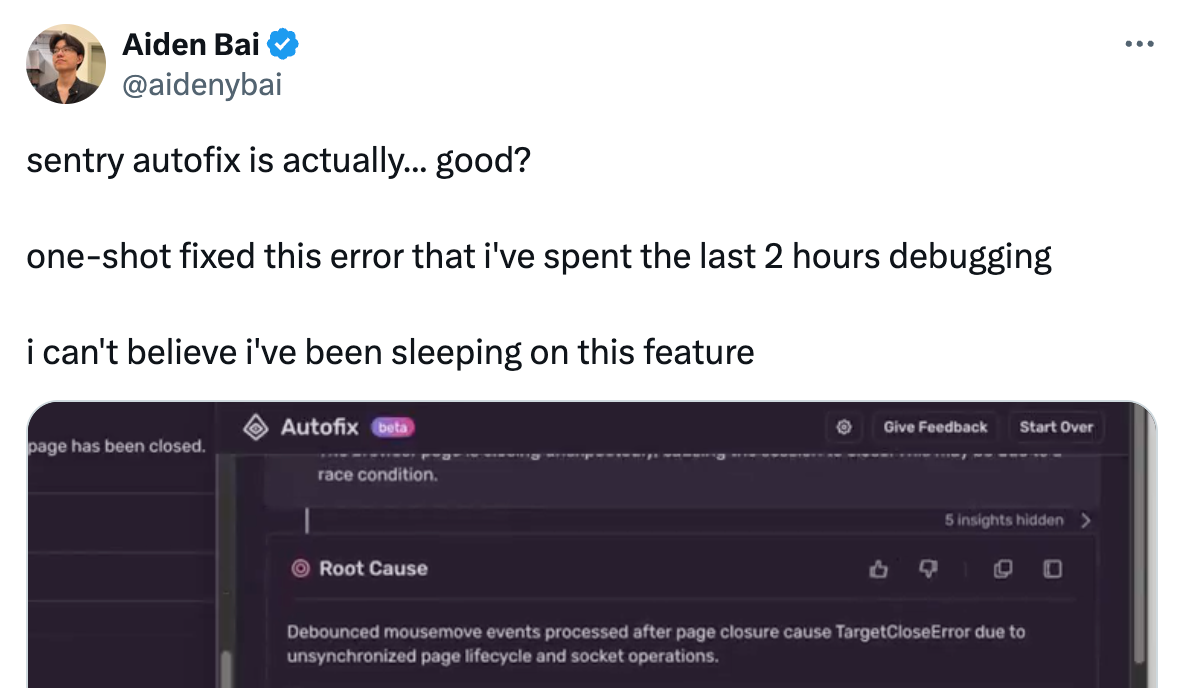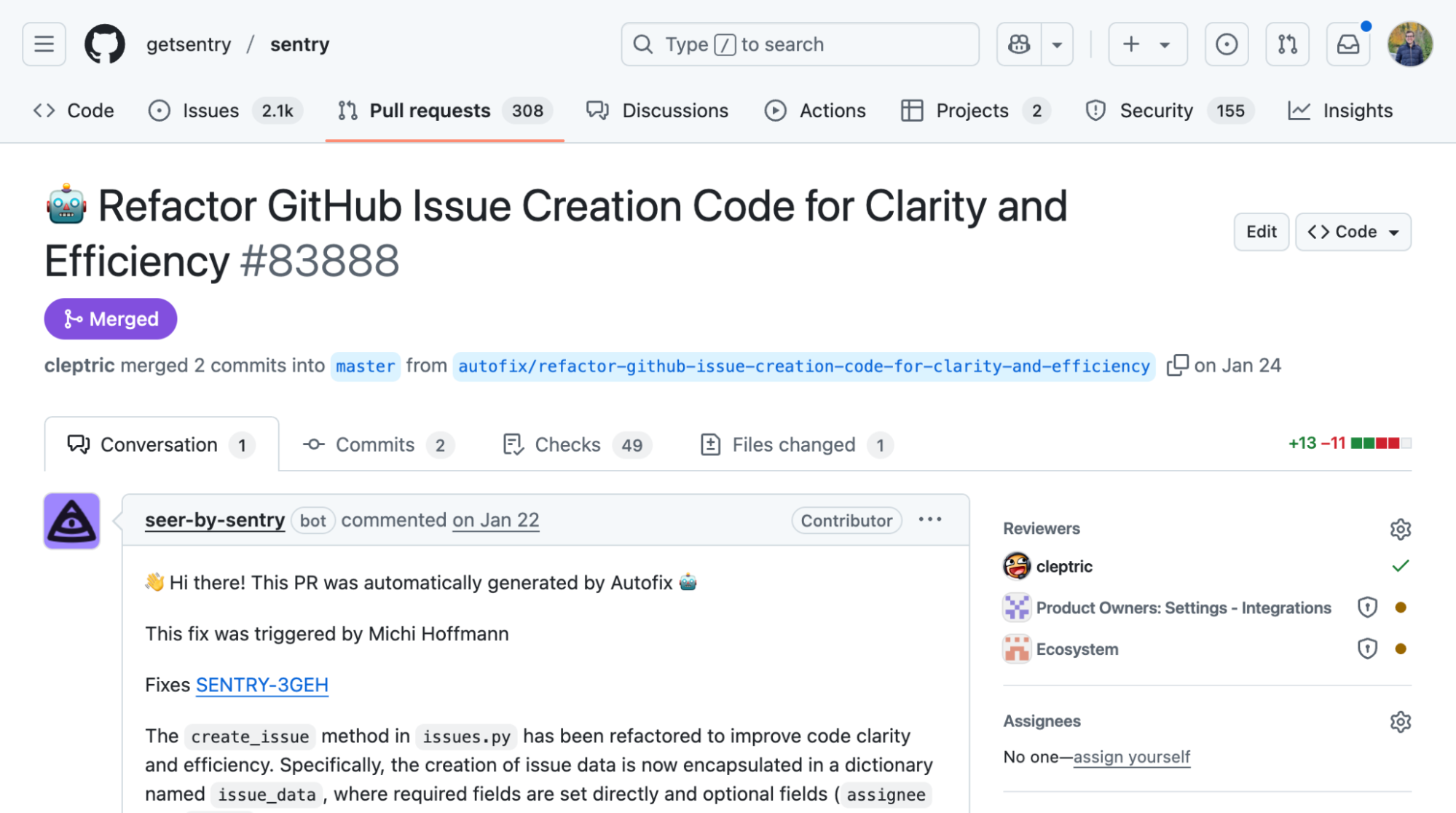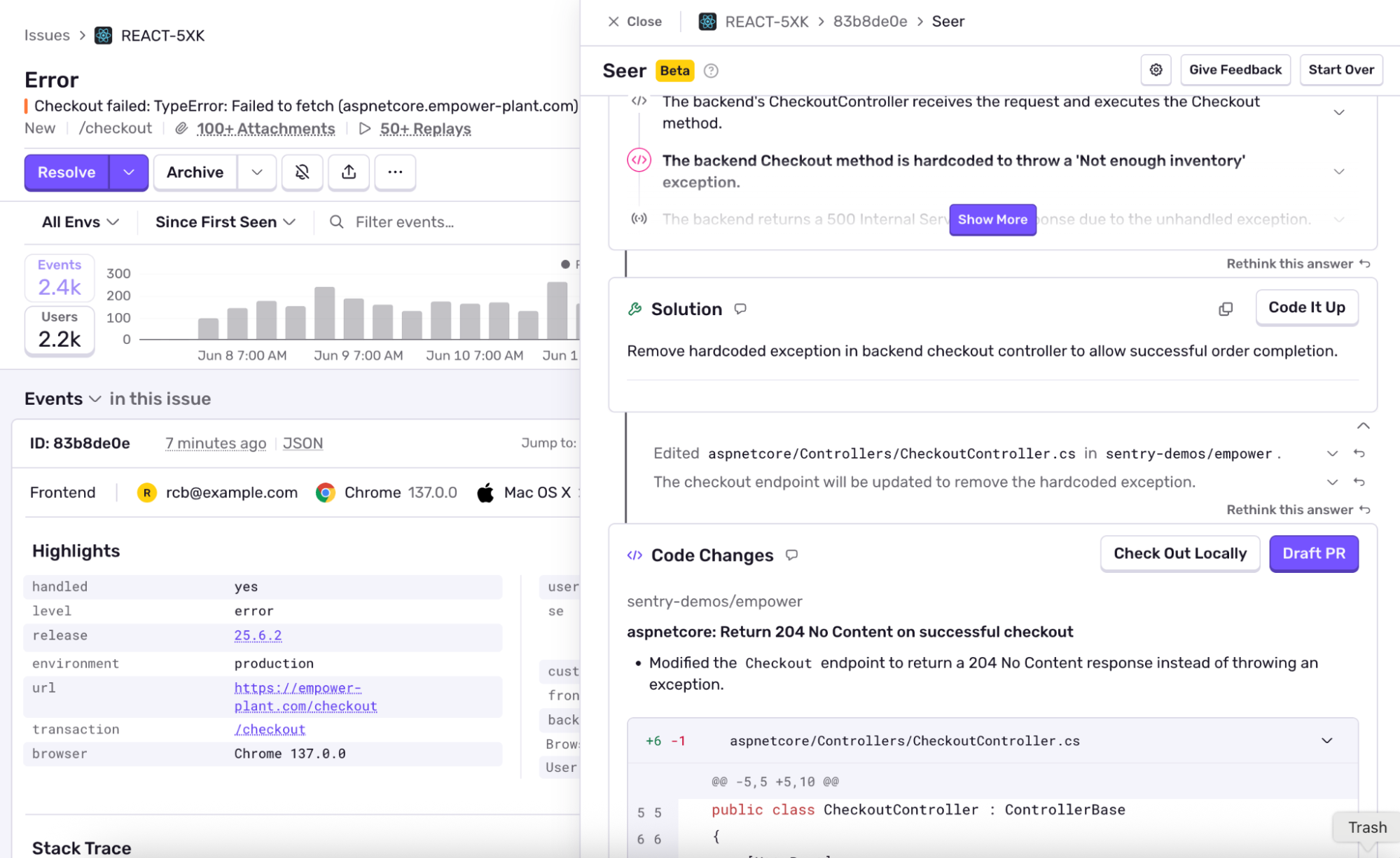Seer, Sentry’s AI Debugger, is Generally Available
Seer, Sentry’s AI Debugger, is Generally Available
Tired of trying to guess if that half-baked LLM suggestion is really going to fix the issue with your code? Meet Seer—our new AI agent that taps into all the issue context from Sentry and your codebase to not just guess, but root cause gnarly issues and propose merge-ready fixes specific to your application.
Code gen tools are great fun—and useful. But even a recent Microsoft study confirmed what you already know: AI struggles with debugging. And as reported here (before Seer GA’d, of course), “Agents excel at localizing, but fail to root cause, resulting in partial or flawed solutions.”
That’s where Seer is different.
Debugging needs deep context. Seer gets it—from the stack trace, the commit history, the traces and spans, and even that haunted line of code someone pushed six months ago. It’s not a hallucinating solution. It’s diagnosing the problem with precision.
Since its beta (you might remember it as Autofix), Seer has:
Analyzed 38,000+ issues
Identified root causes with 94.5% accuracy
Saved devs over 2 years of collective time
The TL;DR?
It’s the debugger you’ve always wished would just show up, figure out what broke and why, tell you how to fix it, and shut the laptop for you.
How does Seer work?
Seer pulls together everything Sentry knows about an issue—stack traces, environment info (browser, OS, etc.), spans, commits, logs (now in beta), and profiling data. It is able to access this context in an agentic fashion - this means we’re not just copy-pasting a bunch of Sentry context, we’re exposing it to Seer as a resource just like code search.
Also, Seer doesn’t just leverage context from all the exceptions Sentry captures — it also taps into your codebase to:
Execute grep-like searches across your files
Parse and interpret documentation
Trace and analyze commit history
Examine multiple repositories to catch potential breaking changes before they happen
Modify files directly when needed
Think uncaught JavaScript exceptions, Rust backend crashes, or slow N+1 queries. That TypeError in a React component? Sentry shows you the error and the commit—Seer takes it further. It analyzes the code, recent changes, and runtime context to root-cause the issue. Maybe it’s an undefined prop or a missing null check—Seer figures it out, suggests a fix, and opens a pull request. No guesswork, no context-switching.
Oh, and one more thing: Seer doesn’t just suggest fixes—it can now fix things for you. Automatically.
Yep. With automated issue scans, Seer keeps an eye on all your incoming issues and highlights the ones that are most actionable—giving you tighter Slack alerts and less noise.
Flip on Automated Fixes, and Seer will go even further: it’ll root cause the issue and draft a solution without you lifting a finger. You stay in control—nothing gets merged without your approval.
No triage. No toil. No wasted cycles. Just real fixes.
What can Seer really fix for me?
Seer can act like your robovac. It will pick up all the scraps and fix basic issues for you while you mow through new feature tickets. Seer's also really good at figuring out tricky problems that involve a bunch of different services talking to each other, because it sees so much data.
Type errors, null dereferences, missing keys — solving simple issues, fast
For routine bugs and performance issues—like unhandled type exceptions ("foo" where an int was expected)—Seer helps clear the backlog fast.
Instead of opening your IDE, creating a new branch, tracking down the relevant code, and writing a fix, Seer can run automatically the moment the error hits Sentry. By the time you see the alert, it’s already proposed a fix. The PR is two clicks away.
“It’s no longer one dev, one PR. I’m running Seer across all our issues in parallel. If a fix is off, no big deal—reject it, give more context, try again. Iteration is cheap, and it’s saving my team days.”
-Neil Wang, Engineering Manager at Curai
We’ve seen it ourselves too. In one case, Seer opened a PR in the Sentry repo (yes, it’s fixing itself) to resolve an exception caused by unhandled None values. All our team had to do was review the diff and hit merge.
Flaky jobs, lost responses, invisible failures — debug complex issues
Seer is like a pair programmer that’s spent 10+ hours reviewing all of the relevant Sentry telemetry data. For example, it uses spans/trace data to infer relationships across repos and projects in complex, distributed systems. And everything from its prompts to its tools is purpose-built and rigorously tested to turn that context into answers—more reliably than any generic AI.
Take Curai Health, an AI-powered healthcare startup with a React Native codebase and a product surface spanning web and mobile. After introducing animated to-dos, a subtle bug slipped past QA — Android expected a gap property in the reordered array, but web didn’t care. Seer read the breadcrumbs, traced the root cause, and surfaced a fix in minutes — something that would’ve taken a developer a full day to track down.
Seer provided insights that led us to a fix within 30 minutes, for a bug that would have taken an engineer at least a day otherwise.
- Neil Wang, engineering manager at Curai Health
In one case, Seer refactored the create_issue method in issues.py to improve clarity and efficiency—grouping required fields into a dictionary, conditionally adding optional fields, and cleaning up formatting. The result? Less redundancy, cleaner diffs, and a more maintainable implementation.
Troubleshoot issues in distributed systems
Troubleshoot issues in distributed systems
Seer can also work across distributed systems in multiple codebases.
In one of our sample apps, Sentry logged a TypeError on the React frontend: "Failed to fetch". Seer traced it through the stack to an ASP.NET backend, where a recent change had broken the API response. The frontend wasn’t handling the null value—because no one told it to.
Seer identified the backend commit, explained the root cause, suggested a fix, and opened a pull request—on the right service.
What do developers think so far?
We’re not usually ones to brag, so we’ll let a few developers do it for us
Even though today’s experience with Seer is already good—like any AI tool, it’s only getting better. We built it to flexibly adopt the best frontier models from OpenAI, Anthropic, Google, and others. As new LLMs become available, we evaluate and integrate them if they improve results.
I've been using Seer firsthand over the past few days, and I must say — the tool looks very promising. The root cause analysis is spot-on, and it's truly impressive work from Sentry to empower developers with such deep insights.
-Bharath Manjunath, Sr. Software Engineer at Sky Network TV
We��’re also expanding what Seer can access inside Sentry. Since the start of the year, we added support for traces, profiles, and logs—session replays are coming soon. We recently shared more about our approach on the blog.
Puts your privacy first
We built Seer with privacy and security front and center. Here’s the short version:
Seer doesn’t use your data to train generative AI models without your explicit consent (it’s off by default).
Your inputs and responses stay private—visible only to you and other authorized users in your Sentry organization.
You can dig into the full details in our AI privacy and security docs.
How can I try Seer?
Seer is available to all Sentry users on a paid plan (Team, Business, or Enterprise). You can try it free for 14 days—no separate setup required.
After the trial, Seer can be added to your subscription for $20/month, which includes $25/month in credits for issue fixes ($1/run) and scans ($0.003/issue).
To get started, just go into any issue and click ‘Find Root Cause’ where you will be prompted to start your free trial. You can connect your GitHub repo to, bring in more insights, unlock automated fixes, and configure your project settings.
Got feedback, feature requests, or a “Seer saved my day” story? We’d love to hear it—email us at seer@sentry.io or come hang out on Discord.










